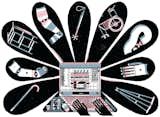Collection by Olivia Martin
A Primer on Universal and Multigenerational Design
One of architecture’s greatest functions is to increase the mobility and comfort of the people who use it. Here, learn how universal and multigenerational design can help those with special needs thrive.
We’ve all seen Braille labels ineptly screwed to walls as an afterthought, with no sensitivity to the overall environment. The irony is that this in itself undermines universal design. Anything so clunky that it is off-putting to anyone who has an alternative by default becomes a special-needs product—and a stigmatizing one at that. If the aspiration is truly universal design, Braille would become part of everyone’s experience, not just that of the people who read it. What if the decorative texture of Braille were designed with sighted people in mind as well, even if it remained illegible and abstract to them? Click to see our entire 101 series on Universal Design.
Showcasing his mastery of light, Monti designed these Cor-ten curtains to modulate the light that enters the home, creating a dappled effect all throughout the house. “Light is such a great resource in California and architects tend to lose that when they look into a space,” says Monti.
Not one to waste any resource, Monti also re-purposed the circular cutouts into a staircase balustrade that adds an artistic element to the home.
As an architect who specializes in universal access design and ADA compliance and as a wheelchair user herself, Karen Braitmayer was no stranger to the challenges of accessible design. Although she had been able to take advantage of her 1954 home's single-level, open layout, as her daughter (also a wheelchair user) grew up, the family's accessibility needs also shifted. The main living area includes a more formal sitting area near the entrance, the dining area, Braitmayer’s workspace, and the kitchen—you can see the couple’s daughter working at the island. In the foreground is a pair of midcentury chairs; at left is a Heywood-Wakefield that Braitmayer found at an antiques shop. Seattle-based designer Lucy Johnson completed the interiors. The windows are from Lindal, and the exterior doors are from Marvin.






